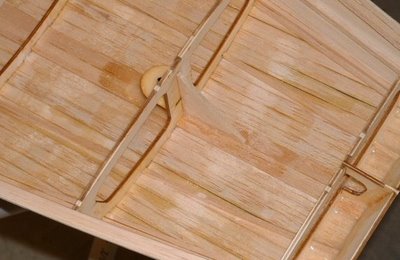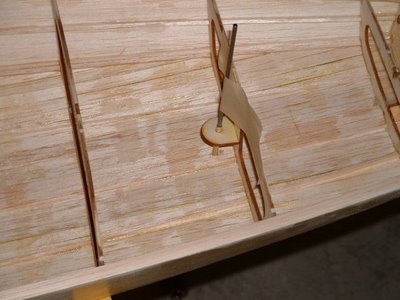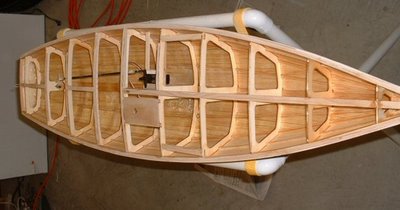There are a few ways to construct building stocks for building a wooden boat but most are variations on the basic method that I will show here. These photos have been sent to me by Fred Grimminck, who has previously built our Didi Mini and is now building the bigger sister, the Didi 950. This is a boat that is designed to fit into the Classe 950 Rule. It is a radius chine plywood boat with hard chine in the topsides.
Freds building stocks, or beds, are on short posts that are fastened to the concrete slab in his workshop. If he were building off earth then the posts would be extended down into the ground about 300-400mm and set in concrete to make them stable. Other than that, the rest of the configuration would be the same.
Click on photos to enlarge, to see detail.
 |
| Didi 950 building stocks looking aft. |
 |
| Didi 950 building stocks looking forward. |
Rails and transverse braces are bolted to the posts. It is good to set the rails accurately so that they can be used as an accurate reference at any stage during construction. That means setting them so that the tops of rails and transverse braces are level, with the centrepoints of the transverse braces on centreline and the rails identically positioned each side of centreline. If any bulkheads will be attached to transverse braces then those transverses need to be set up at 90 degrees to the centreline, which will happen automatically if the two sides of the beds are identical. The centreline string on the beds can be seen in the photos above, providing a good reference for checking accuracy.
 |
| Transom doubler being set up on beds. |
The photo above is of the transom doubler being set up on legs that are bolted to the aft transverse brace. If the transom will not have doublers on the inside then the transom itself would be in this position. This attachment is done in the same way as a bulkhead except that the bulkhead legs are generally bolted to the rails instead of a transverse brace. If you zoom in on the photo you can see the small piece of steel angle that Fred has used to fasten the post at bottom right to the concrete slab. The angle is bolted to the leg and to the slab. This must be done for all of the posts.
A secure and accurate set of building stocks is the foundation for an accurate build. Another essential to get this right is for the waterline and centreline to be accurately drawn onto every bulkhead. These lines will be used in setting up the bulkheads themselves and also many times during construction to set up joinery, engine alignment etc.
 |
| Didi 950 bulkheads being set up on beds. |
Fred is working forward from the transom in setting up the bulkheads but you can work from either end. I normally set up the forward bulkhead first, then work aft. This is because the forward bulkhead may extend below the top of the stocks and need to be either clear of the front transverse brace or attached directly to that transverse.
In Freds photo above, the bulkhead closest to the camera is at the front of the cockpit, so forms the aft end of the cabin and serves as a good example. Each bulkhead must be set up accurately in all directions for the hull to be built to the shape intended by the designer. It must be at the correct location fore/aft, laterally and vertically. It must also be square to the centreline and it must be vertical both fore/aft and laterally.
Correct position fore/aft is done by measurement from the first bulkhead that is set up. Check it also against the distance to the previous bulkhead because this will highlight previous errors that may have been missed.
Correct position laterally is done by means of a plumb bob hung from a line above the stocks that is exactly over the centreline of the stocks. In a building this line can be attached to the ends of the building. If outside it will need posts to be set up beyond the ends of the hull and the line strung between them. The plumb bob is visible in the photos above.
With the plumb bob hanging from this line you have three checks that can be made on each bulkhead. They are lateral position of the bulkhead, vertical alignment of the bulkhead face against the plumb bob string and vertical alignment of the centreline drawn on the face of the bulkhead. This last one is a basic check that one end of the bulkhead is not lower than the other end but is a check only, not the place to set it up accurately.
Correct position vertically can be done with a waterlevel, which is a whole subject of its own and best dealt with in a separate post. An alternative and quicker method is to use a land surveyors theodolite or a laser level that can be set up beyond one end and to one side of the beds, with a clear view of the whole length of the beds. Use this to horizontally align the waterline marked on each bulkhead so that both ends are at the same level and all bulkheads are aligned to that same level.
When each bulkhead has been correctly set up, bolt it to the support legs and brace the legs to prevent movement. Once all bulkheads are aligned and secured, you will be ready to start adding longitudinal structure.
A few things about this process should be noted.
- Wood is a living material, it changes dimensions with variations in humidity and temperature. If you set up a bulkhead on a dry day and a week later you set up the next bulkhead on a humid day, you will find that the dimensions may have changed by a millimetre or two. Work as accurately as you can but dont sweat over these minor changes. If you do, you will chase yourself around correcting and recorrecting whenever the weather changes. Just accept the changes and move on. Constructing the stocks from steel will stabilise them from changes due to humidity but not temperature. If you are like me, you like to work with wood and really dont like working with steel, so you will stick with wood for the stocks as well.
- Dont attach the legs to the stocks or to the bulkheads with wood screws, through-bolt them or use lag screws. Each bulkhead will not weigh a lot when you set it up but by the time that you have added backbone, stringers, sheer clamps, hull skin and possibly even built much of the interior, your wood screws may be bending or even sheering off under the load.
- A solid foundation to build your hull is the principle to aim for. Use diagonal bracing to keep everything at correct relative positions and angles.
- You need to be able to get through between the structures of the building stocks and the hull as it takes shape. You need access at many positions along the hull, not just aft under the transom. That needs the longitudinal rails of the stocks to either be hard against the slab or lifted enough to slide under. I recommend lifting them enough to slide under, which is easy by grabbing the rail with both hands and swinging your body through. If the rails are on the ground you need to hang onto the sheer clamp or some other structure to swing through and you will likely suffer numerous bruises to your back from impact with the rail during the course of the hull construction.
To see more about our designs and buildign methods, please visit http://dixdesign.com/.









 I decided to make templates from the plans for most of the parts in the frames. Using the carbon paper, lines were traced onto material to make the templates. The actual frame pieces were then rough cut, stacked together with double backed tape, the templates double-back taped to the pieces and a trimming router bit with guide bearing used to cut multiple pieces at the same time. In the corners where 1/4" plywood gussets were used, 4 indenticle parts were made at the same time.
I decided to make templates from the plans for most of the parts in the frames. Using the carbon paper, lines were traced onto material to make the templates. The actual frame pieces were then rough cut, stacked together with double backed tape, the templates double-back taped to the pieces and a trimming router bit with guide bearing used to cut multiple pieces at the same time. In the corners where 1/4" plywood gussets were used, 4 indenticle parts were made at the same time.























 All frames had been cut to fit and temporary assemble indoor.70% of the lumber I used are 2nd hand cengal wood. Frames and keel are transferred to a larger space at my yard for assemble.
All frames had been cut to fit and temporary assemble indoor.70% of the lumber I used are 2nd hand cengal wood. Frames and keel are transferred to a larger space at my yard for assemble.
 Stem that cut to desired shape and fitted to the stem knee.
Stem that cut to desired shape and fitted to the stem knee.


 The chines are up,by wrapping the part that needed for bending with some rags and soak with boiling water,this way will soften the lumber to make bending easier.
The chines are up,by wrapping the part that needed for bending with some rags and soak with boiling water,this way will soften the lumber to make bending easier.
 Bottom battens are added to the framework.
Bottom battens are added to the framework.
 Side battens and sheer clamps fitted in firm and aligned.
Side battens and sheer clamps fitted in firm and aligned.
























